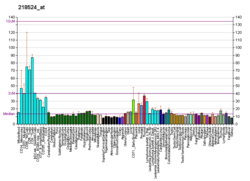E4F1
Giao diện
Nhân tố sao chép E4F1 là một protein ở người được mã hóa bởi gen E4F1.[3][4][5]
Tương tác
[sửa | sửa mã nguồn]E4F1 đã cho thấy có tương tác với:
Tham khảo
[sửa | sửa mã nguồn]- ^ a b c GRCh38: Ensembl release 89: ENSG00000167967 - Ensembl, May 2017
- ^ “Human PubMed Reference:”.
- ^ Saccone S, Sandy P, Meroni G, Gostissa M, Della Valle G, Del Sal G (tháng 11 năm 1998). “Assignment of the E1A-regulated transcription factor E4F gene (E4F1) to human chromosome band 16p13.3 by in situ hybridization and somatic cell hybrids”. Cytogenet Cell Genet. 82 (1–2): 99–100. doi:10.1159/000015075. PMID 9763670.
- ^ Burn TC, Connors TD, Van Raay TJ, Dackowski WR, Millholland JM, Klinger KW, Landes GM (tháng 12 năm 1996). “Generation of a transcriptional map for a 700-kb region surrounding the polycystic kidney disease type 1 (PKD1) and tuberous sclerosis type 2 (TSC2) disease genes on human chromosome 16p3.3”. Genome Res. 6 (6): 525–37. doi:10.1101/gr.6.6.525. PMID 8828041.
- ^ “Entrez Gene: E4F1 E4F transcription factor 1”.
- ^ a b Rizos H, Diefenbach E, Badhwar P, Woodruff S, Becker TM, Rooney RJ, Kefford RF (tháng 2 năm 2003). “Association of p14ARF with the p120E4F transcriptional repressor enhances cell cycle inhibition”. J. Biol. Chem. 278 (7): 4981–9. doi:10.1074/jbc.M210978200. PMID 12446718.
- ^ Sandy P, Gostissa M, Fogal V, Cecco LD, Szalay K, Rooney RJ, Schneider C, Del Sal G (tháng 1 năm 2000). “p53 is involved in the p120E4F-mediated growth arrest”. Oncogene. 19 (2): 188–99. doi:10.1038/sj.onc.1203250. PMID 10644996.
- ^ Fajas L, Paul C, Zugasti O, Le Cam L, Polanowska J, Fabbrizio E, Medema R, Vignais ML, Sardet C (tháng 7 năm 2000). “pRB binds to and modulates the transrepressing activity of the E1A-regulated transcription factor p120E4F”. Proc. Natl. Acad. Sci. U.S.A. 97 (14): 7738–43. doi:10.1073/pnas.130198397. PMC 16614. PMID 10869426.
Đọc thêm
[sửa | sửa mã nguồn]- Maruyama K, Sugano S (1994). “Oligo-capping: a simple method to replace the cap structure of eukaryotic mRNAs with oligoribonucleotides”. Gene. 138 (1–2): 171–4. doi:10.1016/0378-1119(94)90802-8. PMID 8125298.
- Fernandes ER, Rooney RJ (1997). “The adenovirus E1A-regulated transcription factor E4F is generated from the human homolog of nuclear factor phiAP3”. Mol. Cell. Biol. 17 (4): 1890–903. PMC 232036. PMID 9121437.
- Suzuki Y, Yoshitomo-Nakagawa K, Maruyama K, Suyama A, Sugano S (1997). “Construction and characterization of a full length-enriched and a 5'-end-enriched cDNA library”. Gene. 200 (1–2): 149–56. doi:10.1016/S0378-1119(97)00411-3. PMID 9373149.
- Rooney RJ, Daniels RR, Jenkins NA, Gilbert DJ, Rothammer K, Morris SW, Higgs DR, Copeland NG (1998). “Chromosomal location and tissue expression of the gene encoding the adenovirus E1A-regulated transcription factor E4F in humans and mice”. Mamm. Genome. 9 (4): 320–3. doi:10.1007/s003359900758. PMID 9530632.
- Kim ST, Lim DS, Canman CE, Kastan MB (2000). “Substrate specificities and identification of putative substrates of ATM kinase family members”. J. Biol. Chem. 274 (53): 37538–43. doi:10.1074/jbc.274.53.37538. PMID 10608806.
- Sandy P, Gostissa M, Fogal V, Cecco LD, Szalay K, Rooney RJ, Schneider C, Del Sal G (2000). “p53 is involved in the p120E4F-mediated growth arrest”. Oncogene. 19 (2): 188–99. doi:10.1038/sj.onc.1203250. PMID 10644996.
- Fajas L, Paul C, Zugasti O, Le Cam L, Polanowska J, Fabbrizio E, Medema R, Vignais ML, Sardet C (2000). “pRB binds to and modulates the transrepressing activity of the E1A-regulated transcription factor p120E4F”. Proc. Natl. Acad. Sci. U.S.A. 97 (14): 7738–43. doi:10.1073/pnas.130198397. PMC 16614. PMID 10869426.
- Rizos H, Diefenbach E, Badhwar P, Woodruff S, Becker TM, Rooney RJ, Kefford RF (2003). “Association of p14ARF with the p120E4F transcriptional repressor enhances cell cycle inhibition”. J. Biol. Chem. 278 (7): 4981–9. doi:10.1074/jbc.M210978200. PMID 12446718.
- Fenton SL, Dallol A, Agathanggelou A, Hesson L, Ahmed-Choudhury J, Baksh S, Sardet C, Dammann R, Minna JD, Downward J, Maher ER, Latif F (2004). “Identification of the E1A-regulated transcription factor p120 E4F as an interacting partner of the RASSF1A candidate tumor suppressor gene”. Cancer Res. 64 (1): 102–7. doi:10.1158/0008-5472.CAN-03-2622. PMID 14729613.
- Nakamura Y, Igarashi K, Suzuki T, Kanno J, Inoue T, Tazawa C, Saruta M, Ando T, Moriyama N, Furukawa T, Ono M, Moriya T, Ito K, Saito H, Ishibashi T, Takahashi S, Yamada S, Sasano H (2005). “E4F1, a novel estrogen-responsive gene in possible atheroprotection, revealed by microarray analysis”. Am. J. Pathol. 165 (6): 2019–31. doi:10.1016/s0002-9440(10)63253-1. PMC 1618705. PMID 15579445.
- Rual JF, Venkatesan K, Hao T, Hirozane-Kishikawa T, Dricot A, Li N, Berriz GF, Gibbons FD, Dreze M, Ayivi-Guedehoussou N, Klitgord N, Simon C, Boxem M, Milstein S, Rosenberg J, Goldberg DS, Zhang LV, Wong SL, Franklin G, Li S, Albala JS, Lim J, Fraughton C, Llamosas E, Cevik S, Bex C, Lamesch P, Sikorski RS, Vandenhaute J, Zoghbi HY, Smolyar A, Bosak S, Sequerra R, Doucette-Stamm L, Cusick ME, Hill DE, Roth FP, Vidal M (2005). “Towards a proteome-scale map of the human protein-protein interaction network”. Nature. 437 (7062): 1173–8. doi:10.1038/nature04209. PMID 16189514.
- Paul C, Lacroix M, Iankova I, Julien E, Schäfer BW, Labalette C, Wei Y, Le Cam A, Le Cam L, Sardet C (2006). “The LIM-only protein FHL2 is a negative regulator of E4F1”. Oncogene. 25 (40): 5475–84. doi:10.1038/sj.onc.1209567. PMID 16652157.
- Le Cam L, Linares LK, Paul C, Julien E, Lacroix M, Hatchi E, Triboulet R, Bossis G, Shmueli A, Rodriguez MS, Coux O, Sardet C (2006). “E4F1 is an atypical ubiquitin ligase that modulates p53 effector functions independently of degradation”. Cell. 127 (4): 775–88. doi:10.1016/j.cell.2006.09.031. PMID 17110336.
- Cvetanovic M, Rooney RJ, Garcia JJ, Toporovskaya N, Zoghbi HY, Opal P (2007). “The role of LANP and ataxin 1 in E4F-mediated transcriptional repression”. EMBO Rep. 8 (7): 671–7. doi:10.1038/sj.embor.7400983. PMC 1905893. PMID 17557114.



